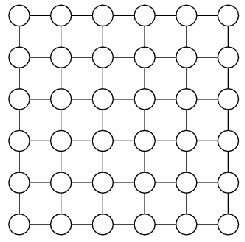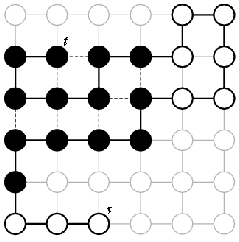1372 . 2D Folding Game
Description
Nintendo Game Company develops a game played on a two-dimensional square lattice (2D-lattice). A 2D-lattice can be viewed as a graph with vertex set V = {[a, b]| a, b ∈ Z}. The vertices are
represented as ordered pairs and two vertices are adjacent if and only if the corresponding squares share
a side of lattice. Figure 1 illustrates a 2D-lattice. Given a sequence of length m over the symbols 0 and
1, the conformations of the sequence are restricted to self-avoiding paths embedded in a 2D-lattice,
where a self-avoiding path is a path in a 2D-lattice that does not visit the same vertex more than once.
The detailed description of the game is as follows.

Let p = p1 ... pm be a sequence of length m over symbols 0 and 1, and let = (V, E) be a
2D-lattice. An embedding of p into is an injective function φ : {1,...,m} → V from the positions of the sequence to the vertices of the lattice that assigns adjacent positions in p to adjacent vertices in
, i.e., (φ(i), φ(i + 1)) ∈ E for all 1 ≤ i ≤ m − 1. These edges (φ(i), φ(i + 1)) ∈ E for 1 ≤ i ≤ m − 1 are called binding edges. An embedding of p into
is called a conformation. An edge (x, y) of
is called contact edge if it is not a binding edge, but there exist i, j ∈ {1,...,m} such that φ(i) = x, φ(j) = y,
and pi = pj = 1.
The score of a conformation φ equals the number of the contact edges in . Figure 2 illustrates a conformation with score 7. An optimal conformation of a sequence in
is a conformation that
maximizes the number of contact edges. Given a sequence, a player is asked to find an optimal conformation and your task is to write a computer program to compute the score of an optimal conformation.

Figure 2: A conformation of the sequence 0001111110000001111111, where “ • ” represents 1,
“ ◦ ” represents 0, the bold edges represent the binding edges, and the dotted edges represent the
contact edges. The score of this conformation equals 7. In addition, s and t are the beginning
0 and the ending 1 of the sequence.
Input Format
For each test case, there are two lines: the first line contains a positive integer 1 ≤ m ≤ 20, where m is
the number of symbols in the given sequence and the second line represents the sequence of length m.
The next test case is separated from the previous test case by one empty line. A test case that starts
with m = 0 denotes the end of the input file.
Technical Specification
1 ≤ m ≤ 20
Output Format
For each test case, output the score on one line.
Sample Input 1
3 000 4 1111 7 1001001 0
Sample Output 1
0 1 2
Hints
Problem Source
Migrated from old NTUJ.
The ACM-ICPC 2010 Asia Regional Contest, Site Kaohsiung
Subtasks
| No. | Testdata Range | Score |
|---|